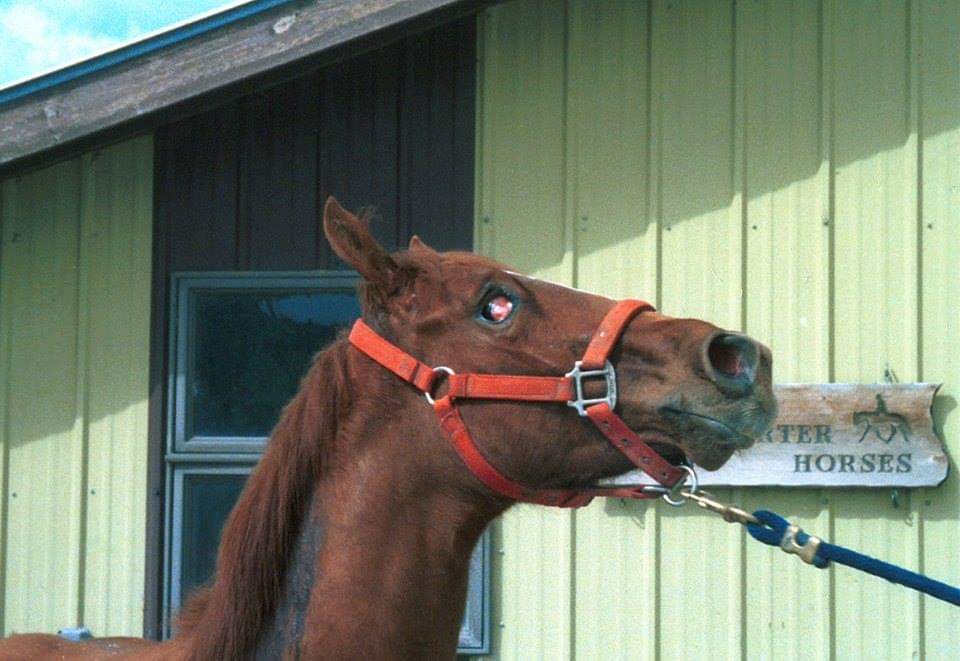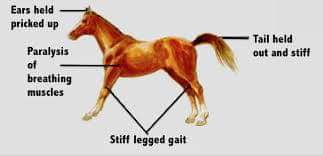TETANUS IN LIVESTOCK –PREVENTION & TREATMENT
TETANUS is a bacterial disease that can affect most animals. Horses are particularly susceptible because of their environment and tendency to incur injuries. Sadly, infected horses and ponies usually die or require euthanasia.
What causes tetanus?
Tetanus is caused by the bacterium Clostridium tetani which can be found in soil and droppings just about everywhere. It survives in the environment for long periods of time. It enters the body through wounds, particularly puncture wounds if the wound is dirty. Puncture wounds on the sole of the foot are common sites of infection. Infection can be acquired via the intestines, after eating contaminated soil or droppings, through gastric or intestinal ulcers. In foals, infection can occur via the umbilicus (navel). The tetanus bacteria do not need oxygen (they are classified as ‘anaerobic’ bacteria) and multiply rapidly in the damaged tissues at the site of the injury. They produce a toxin (tetanus toxin) and it is this potent neurotoxin that causes the classical signs of tetanus.
Transmission of bovine tetanus———
Transmission commonly occurs when an unaffected animal has become exposed due to an injury resulting in an open wound. The cow is then susceptible to infection as the bacteria residing in contaminated soil are in effect given an entry point leading to the bloodstream. Cows are usually infected when wounded by contaminated nails or barbed wire. In some case, cows that have undergone surgery such as castration or calving become infected by bovine tetanus. Such nails and barbed wire are likely to have rusted.
The bacteria can survive in anaerobic conditions in the soil for very long periods of time. They are so resilient that they are unaffected by most disinfectants or high temperatures. This means that the disease is especially prevalent and difficult to eradicate, thus contributing to the spread of the bovine tetanus bacteria.
What are the symptoms?
Tetanus toxin attacks nerves controlling the muscles of the body. This causes progressively worsening muscular stiffness and spasm. The affected horse will become stiff and have difficulty moving and eating. The third eyelid (membrana nictitans, a membrane which can be easily seen at the inner corner of the eye) starts to protrude across the eye, particularly if the horse is startled. The tail is often held out straight and the horse develops an anxious expression because of facial muscle spasm. Any stimulus such as loud sound, bright light or touch can exacerbate the signs. The horse may sweat. In advanced cases the horse will collapse with spasms, convulsions and death from respiratory failure.

Clinical signs
• Stiffness and reluctance to move are normally the first signs
• Twitching and tremors of the muscles
• Lockjaw
• Prominent protruding third eyelid
• Unsteady gait with stiff held out tail
• Affected cattle are usually anxious and easily excited by sudden movements or handling.
• Bloat is common because the rumen stops working
• Later signs include collapse, lying on side with legs held stiffly out, spasm and death.
Symptoms of bovine tetanus
Initially, the cow will experience and show signs of increased sensitive to noise and light. The cow will react in a more excited manner and seem more irritable. Often, these signs are not noticed and farmers remain unaware of infection by the bacteria causing tetanus. The stress caused by this for the cow may aid in the development of infection. A high temperature may also be presented.
The progression of the symptoms provides an indication as to when the toxins are being produced. The cow will become stiff and will show a disinclination to move. The muscles may begin to tremor and signs of stiffness in the limbs, neck and tail will be observed. As a result the cow will seem uncoordinated and raise its tail. The cow’s jaw may stay in a state of permanent contraction and this is known as “lock jaw” and the cow will be unable to eat effectively. Additionally, the rumen may halt and this can lead to bloat.
In the later stages, the muscles will further contract and spasm. Protrusion of the third eye occurs mostly when the head is raised and often leads to a positive diagnosis. The disease becomes fatal when the cow collapses, convulses in addition to having very stiff legs.
Respiratory failure can also lead to death but often the cow is destroyed humanely before this can occur.
Diagnosis of bovine tetanus ————–
Signs and symptoms which are observed often lead to a positive diagnosis for bovine tetanus. Open wounds where the bacteria are thought to have entered can be used to produce cultures of the bacteria although, due to the complex nature of identifying this type of small bacteria, this method is rarely used.
Can tetanus be treated?
Most cases of tetanus ultimately result in death of the affected animal. If diagnosed early, treatment is aimed at destroying the bacteria so that no more toxin is produced and reducing the effects of the toxin that has already been produced. Large doses of antibiotics, usually penicillin, are used in conjunction with Tetanus Antitoxin injected usually intravenously and intramuscularly. If the horse is able to eat, food should be offered at a height where it can easily reach it. In severe cases, slinging may be necessary. Intravenous fluids and/or catheterization of the bladder may also be necessary. Unfortunately, the chances of recovery are extremely poor if such measures are necessary and euthanasia on humane grounds is usually more appropriate.
Treatment
Cattle diagnosed with bovine tetanus are treated using the tetanus antitoxin at the late stages of infection. Before this, however, antibiotics such as penicillin can treat the infected animal. Stress should be reduced and so sedation is sometimes required as well as placing the animal in a darkened area with little noise. If the infection has been diagnosed to late and the tetanus is in its most severe form, treatment is rarely given and the animal dies or is culled.
Prevention
Undertaking surgical procedures (such as castration) properly, in a clean environment, with disinfected instruments and surgical area, will significantly reduce the risk of tetanus. The same rules apply to calving, be as clean as possible and minimise contamination.
Antitoxin can be useful as a short-acting (up to 21 days) preventative if used at high risk times, however on some farms vaccination may be better, as a three dose course of vaccination can result in protection for over three years
How can tetanus be prevented?
Tetanus is an easily preventable disease. Vaccination with ‘tetanus toxoid’ should be used for all horses and ponies. The initial course consists of two injections given approximately four to six weeks apart followed by boosters at two-year intervals.
Foals cannot respond to vaccine given before approximately four months of age but should start a course of vaccine soon after this. As protection before this age foals usually receive tetanus antitoxin soon after birth. They also receive some protection via colostrum (first milk) if the mare is well vaccinated.
Good first aid can help prevent tetanus. Wounds should be cleaned as soon as they occur and steps should be taken to encourage drainage of deeper injuries. Paddocks, stables and stable yards should be kept safe, clean and clear of dangerous items such as old tractor parts, corrugated iron sheets and building materials that may cause injury.
Vaccines are available to protect against bovine tetanus which can last as long as three years if given in the correct doses at the correct times. These are usually used in areas of high risk. In these cases, vaccines are seen to prove economically worthwhile to farmers when compared to if the cattle were to actually become infected. Symptoms of the disease are generally milder in cattle that have vaccinated as opposed to those that have not.
In other cases, good hygiene is needed especially during and following operations such as castrations and calving. The spread of the disease can be reduced by ensuring that all surgical equipment are sterilised and the operation is undertaken in a clean area. Barbed wire which has rusted should be replaced as these can also act as a source of infection and any open wounds cleaned immediately
Tetanus is a fairly common disease occurring in all types of livestock. It is relatively rare in cattle, but outbreaks of disease can cause very severe losses.
Prognosis
The prognosis is almost always poor when the infection of unvaccinated animals has resulted in a full blown case of tetanus and so this usually leads to death.
Compiled & Shared by- Team, LITD (Livestock Institute of Training & Development)
Image-Courtesy-Google
Reference-On Request.


